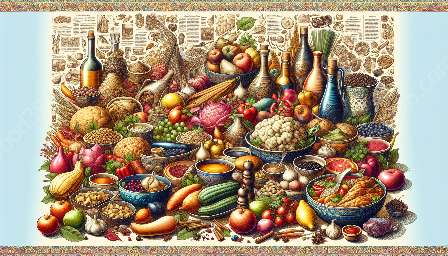The cross-cultural exchange of culinary practices along international borders is a fascinating phenomenon that has greatly influenced food culture around the world. This topic explores the ways in which geographical factors shape culinary traditions and the origin and evolution of distinct food cultures.
Influence of Geography on Food Culture
Geography plays a significant role in shaping food culture, as it influences the availability of ingredients, climate, and local agricultural practices. Along international borders, the intersection of different geographical regions often leads to a rich exchange of culinary practices. For example, the fusion of Mexican and Texan cuisines along the Mexico-US border has resulted in the development of Tex-Mex cuisine, which incorporates elements of both cultures.
Similarly, the culinary practices along the Silk Road, an ancient network of trade routes connecting the East and West, facilitated the exchange of ingredients and techniques, giving rise to a diverse array of fusion cuisines that reflect the geographic diversity of the regions.
Culinary Fusion and Adaptation
One of the most intriguing aspects of cross-cultural culinary exchange is the fusion and adaptation of dishes as they travel across borders. This process often creates entirely new culinary traditions and can be seen in the development of dishes such as sushi burritos in the United States, which melds Japanese and Mexican culinary elements.
Moreover, the influence of geography on food culture can also be observed in the adaptation of traditional dishes to suit new environments. For instance, the migration of Indian communities to different parts of the world has led to the evolution of regional variations of Indian cuisine, influenced by the availability of local ingredients and the preferences of the host communities.
Immigrant Influence on Food Culture
Immigrant communities play a significant role in shaping food culture along international borders. The culinary traditions they bring with them often blend with local cuisines, resulting in a diverse and vibrant food landscape. For example, the integration of Chinese culinary practices in countries like Malaysia and Peru has led to the creation of unique hybrid cuisines that reflect the cultural exchange between the immigrant communities and the local populations.
Origin and Evolution of Food Culture
The origin and evolution of food culture are closely linked to the movements of people and the exchange of culinary practices across borders. As societies interact and trade, the sharing of ingredients, cooking methods, and cultural traditions contributes to the development of unique food cultures.
Historical factors, such as colonization and exploration, have also left lasting imprints on food culture. The spice trade, for instance, played a pivotal role in connecting distant regions and introducing new flavors and ingredients to different culinary traditions. This exchange of foodstuffs and culinary knowledge resulted in the enrichment and diversification of food cultures worldwide.
Modern Influence of Cross-Cultural Exchange
In the modern era, globalization and increased connectivity have further accelerated the cross-cultural exchange of culinary practices. The widespread availability of international ingredients and the popularity of fusion cuisine demonstrate the ongoing impact of cross-border culinary exchange on food culture.
Moreover, the rise of food tourism has enabled individuals to explore and experience diverse culinary traditions from around the world, contributing to a deeper appreciation of the interconnectedness of global food cultures.
Preservation of Culinary Heritage
While culinary exchange continues to shape food cultures, it is also important to recognize the significance of preserving traditional culinary practices and heritage. Efforts to safeguard traditional recipes, cooking techniques, and culinary rituals are essential in maintaining the authenticity and uniqueness of food cultures along international borders.
Through initiatives such as food festivals, cultural exchanges, and documentation of traditional cooking methods, communities can celebrate their culinary heritage while embracing the dynamic influences of cross-cultural exchange.


